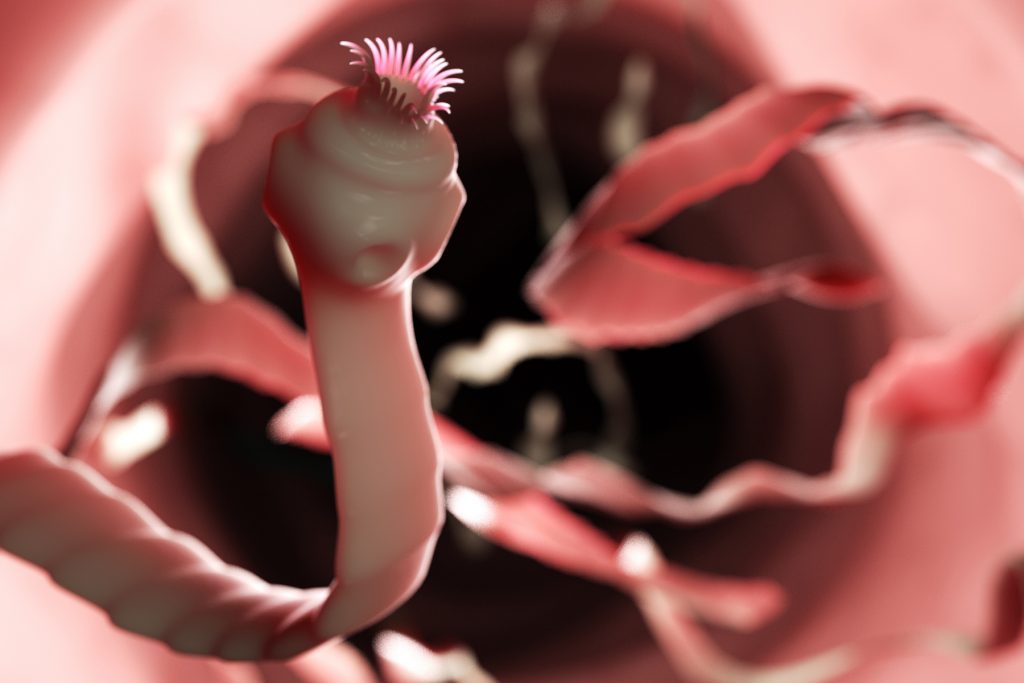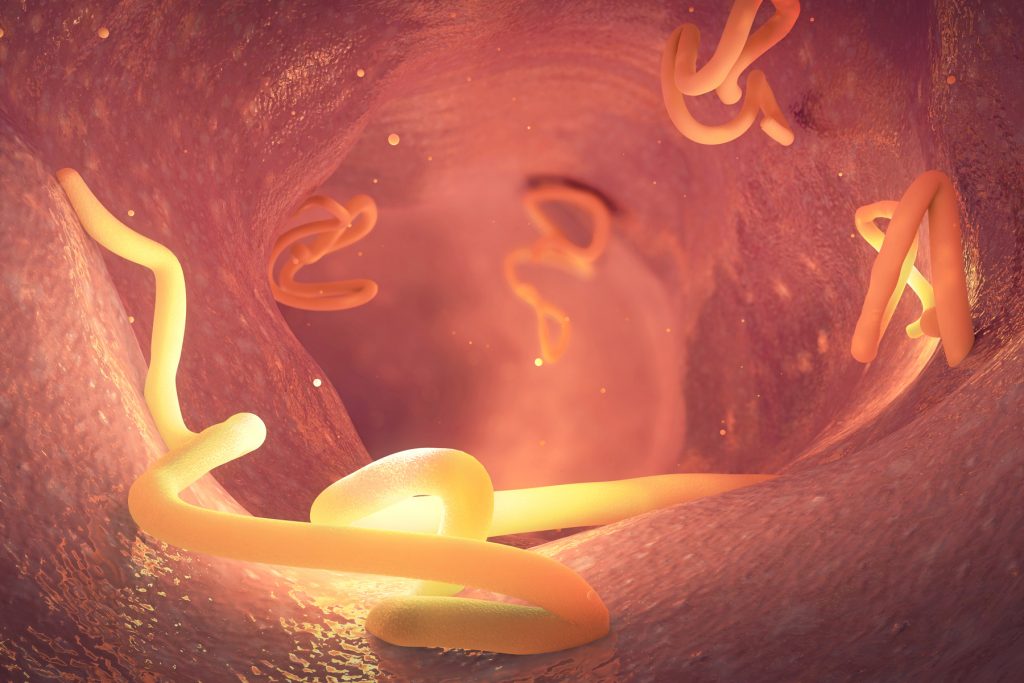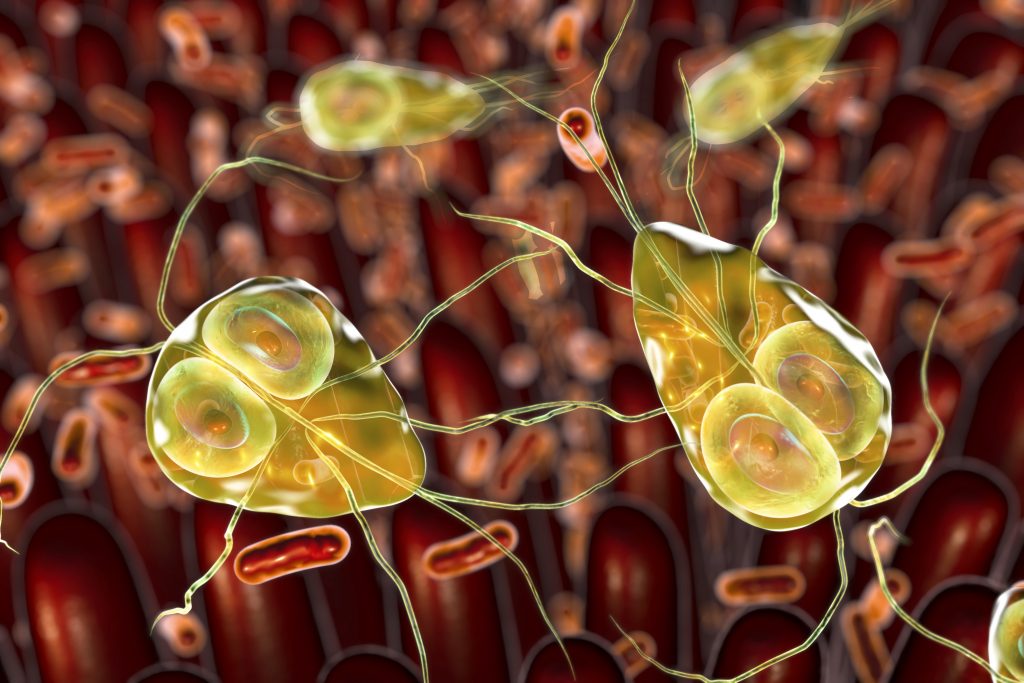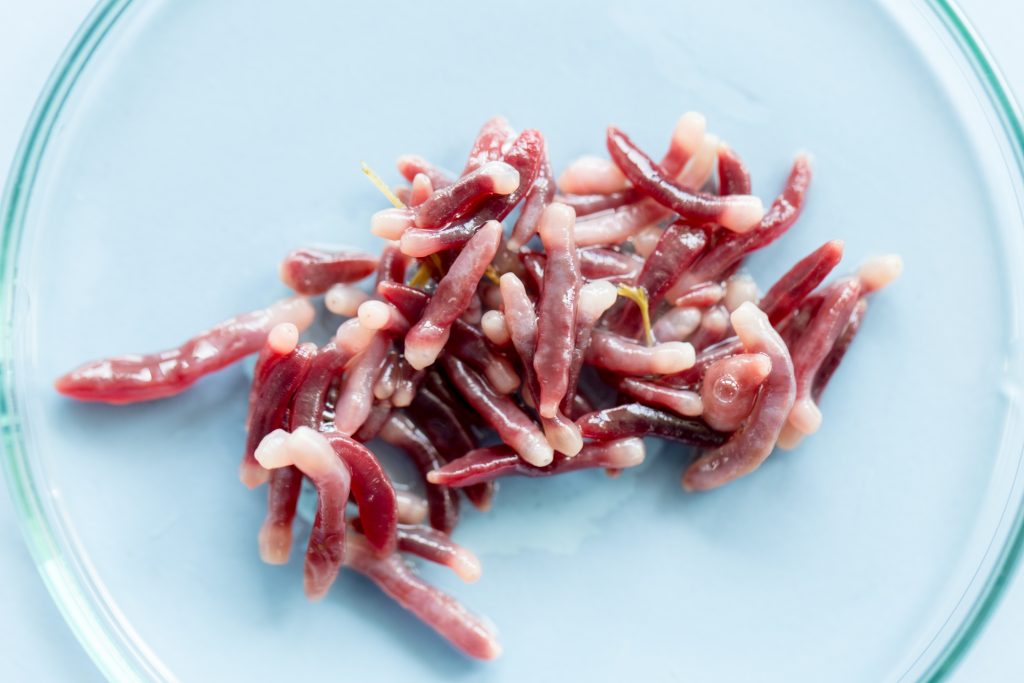One third of us have one or more parasites—You think this is surprising given modern sanitation in modern countries? Think again.
LIVING IN SANITIZED COUNTRIES? Fish, produce, nuts, pork… carry parasites; especially if they are farmed or commercial.
We only become infected when our innate defense system is compromised:
- Taking antacids in any form that lower out first defense—stomach acid;
- Immune imbalances that leave us imbalanced and susceptible;
- Leaky gut because we eat (even miniscule amounts) of foods that inflame our digestive tract.
We think we can get parasites only by visiting impoverished countries. Not true. Over half of all Americans become infected with intestinal parasites at some point in their lives—usually more than once.
Parasite: Anything that lives on you or in you and that robs your nutrients while leaving behind toxic waste and giving you nothing beneficial in return. Even malignant tumors behave much like parasites, stealing your nutrients and returning waste products that cause all sorts of symptoms.
Although this broad idea of parasites could cover all infectious diseases; we use the word “parasite” to specify invading protozoa, amoebas, flukes, and worms. These hitchhikers can be microscopic, a few centimeters, or in the case of tapeworms and some roundworms, quite, well, large.
You do not need a passport or travel to a third world country to get parasites, you get them:
- by not believing they are everywhere,
- by having an inflamed, leaky gut,
- by having chronic inflammation that weakens your immune system,
- by having low stomach acid—including using antacids.
Although international travel exposes us to a longer list of creatures, the most common infections are from our own soil, and food, and water, right here in the U.S.
Vital GI tract definitions:
Probiotic: Truly helpful bacteria that help digest foods, rebalance our hormones, help eliminate toxic chemicals and metals… vital for gut health… we give them a place to live and food, they help us in return.
Commensal: Means the “bug” benefits while the “host” is unaffected. We have a microbiome of bacteria, viruses, yeast… that live in us and help us. They can become imbalanced but should not be eliminated indescriminately. Antibiotics kill both commensal and probiotic bacteria—they do nothing to change viral, yeast, or parasite infestations. Know what you have!
Parasites: can live for years in us for years undetected while robbing our health.
How do I know if I have a parasite infection?
Unfortunately, stool (and other) tests are imprecise; and the spectrum of problems caused by parasites range from no noticeable symptoms at all to severe:
- gastrointestinal tract discomfort and recurrent diarrhea (dysentary)
- alternating diarrhea and constipation,
- bloating, gas, abdominal pain or cramps,
nausea, - general weakness or fatigue that is not relieved no matter how much rest you get,
- weight gain or loss,
- intestinal toxemia,
- itching around the anal or urogenital openings,
- anemias from nutrient deficiencies,
- headaches, seizures, and other neurologic problems,
- acne, skin problems,
- unexplained hair loss,
- arthritis (presumably from the toxins they release),
- allergies, post nasal drip, congestion,
- hormone imbalances.
Parasites produce toxins that can create symptoms anywhere in your body and put heavy burden on the liver and intestines.
Because these unwanted guests steal your nutrients, you need more than you are probably getting. And your low energy may cause sugar cravings or a ravenous appetite.
Parasites often go unrecognized because we tend to chase symptoms. And, because doctors traditionally associate parasites with gastrointestinal problems, parasites get overlooked as a source of other health issues.
Worse, the greatest danger is self-diagnosis. If you do not know what you really have, you cannot treat it!
More on stool tests:
If they are living in your intestines, the laboratory may find them if you send multiple stool samples from multiple days. Many (most?) parasites live elsewhere. One lab I use evaluates urine for compounds the parasites release. BUT your complete blood count (CBC) with differential may tell the story if your eosinophils are high (a good place to start, just not always detectable).
Direct resonance testing—an advanced Nutrition Response Testing technique—can determine the class of infection; without naming names. It can distinguish whether you have a parasite and what type, as opposed to bacteria, virus, yeast, or allergy, and can also locate the infection in the body if need be.
Types of parasites require specific treatment strategies.
Antibiotics do not work on parasites (or viruses or yeast),
- Medical treatments aimed at suppressing inflammation, such as steroids, can cause a subclinical parasite infection to worsen by blocking your immune system.
- The general class of parasite tells one how to treat.
- Vital we understand if it is a parasite and what class.
What sort of parasite do I have?

There are some 3,200 different varieties of parasites divided into four main groups:
- Tapeworms and other large egg-laying parasites,
- Roundworms and pinworms that lay eggs,
- Flagellates like giardia,
- Flukes and other trematodes that range from microscopic to a couple of centimeters.
Each type must be treated in its own way:
- Once you start, treatment must be continued until the infection is completely gone.
- Parasites develop resistance to treatments. The weaker are killed first while the strong survive and multiply.
- Treatment must be maintained and sometimes cycled long enough to kill all, kill all their descendants, and kill all their dormant eggs. This is also true for antiparasitic drugs.
How do I get rid of these unwanted guests?
Most treatment approaches depend on which category(ies) of parasites live in you. To be truly effective, an anti-parasite program must consider the stages of parasite development. Treatment regimens must eliminate the adults and then also eliminate successive generations of grubs and larvae before they mature.
The strong pharmaceutical drugs available to treat parasitic infections are very hard on the body. Most anti-parasite drugs work by being toxic to all life; hopefully more toxic to the parasite than they are to you.
- There are very effective herbs and enzymes that support your liver, intestines, heart, kidneys, skin… and can break down and eliminate parasitic tocix waste with very few side effects.
- Remember, your organs and nutrient status are already compromised; the parasites hijacked your food.
- Parasite class-specific herbs or enzymes (depnding on whether you have egg layers, worms, flukes, etc.). These will rotate to address your specific unwanted guests.
- “Drainage” helps your body eliminate their toxicity that is causing you to feel poorly.
- Whole food nutrients aid your body in healing intestinal or organ inflammation.
- Whole food nutrients to fix malnourishment, including vitamins A and B6. In fact, some scientists think that vitamin A deficiencies increase the risk of parasitic infections. Further, there are certain nutrients to avoid during a parasite cleanse. Let your Nutritionist know everything you are taking.
Treating each parasitic group:

1. Tapeworms (Cestoda): Tapeworms generally set up house in the intestinal tract. The most common varieties are Taenia saginata (beef tapeworm) and Taenia solium (pork tapeworm) which can be 15-30 feet long but, despite their size, there are often no digestive symptoms. Infestation usually occurs from eating uncooked or improperly prepared meat, especially beef or pork, and sometimes fish or even poor quality grains.
If your gut is “leaky”, tapeworm larvae can travel to other parts of the body and set up residence as cysts—encased in a protective layer that also protects it from your immune system. Cysts cause fatigue in that organ, if in the brain can result in headaches, seizures, confusion, or other neurologic symptoms. Rarely, cysts develop in the eyes, sometimes causing blindness, or in the spinal cord, sometimes causing muscle weakness or paralysis.
A typical tapeworm consists of a scolex (head) with hooks and suckers by which it attaches itself to the wall of the intestine. The body of the worm is a series of segments; sometimes several thousand segments. Usually there is just a single adult tapeworm that secretes a toxin to keep its many thousands of eggs from hatching until it dies.

2. Roundworms (Nematoda): Members of this class include true roundworms, threadworms, hookworms, which vary in size from tiny to the thickness of a pencil and 13 inches long. They are cylindrical or spindle-shaped worms possessing a collagen cuticle or surface.One person can have 100 roundworms that can each lay up to 300,000 eggs in a day. The egg(s) hatch into larvae in the lower intestines. They then migrate through intestinal walls and travel via the lymphatic system or the blood to the lungs or muscle, most commonly. Eventually, the larvae return to the small intestines and mature into adults. The adults remain in the intestines and feed on what you eat, especially sugar and starch.
The source of infection is often fish, pork, eggs or larva in contaminated soils, vegetables, also mosquitoes or flies.
3. Protozoa: Unlike the complex worms and flukes, protozoa are single-celled microscopic parasites that migrate through the blood stream to all parts of the body. Examples are Giardia (the most prevalent parasite in the United States) and amoebic dysentery which may be contracted from various water supplies, unclean food preparation, handling infected pets or animals, diaper changing, swimming, and water recreation activities. Transmission is fecal-oral. The protozoan cyst is shed in the feces and later enters the body through the mouth.
 4. Flukes (Trematoda): Flukes commonly travel through the tissues and settle in the liver, kidneys, lungs, pancreas or intestinal tract. Fluke eggs usually hatch in a pond and start their larval stage in snails or minnows. Later, they are shed and attach themselves to foliage to go through a cyst stage until the foliage is eaten by an animal (iincluding humans). In the animal, they come out of the cyst stage and attach themselves to the intestinal wall or their favorite organ where they mature into 0.3-1 inch long adults and live for many years. Those that favor the intestine can lay thousands of eggs per bowel movement.
4. Flukes (Trematoda): Flukes commonly travel through the tissues and settle in the liver, kidneys, lungs, pancreas or intestinal tract. Fluke eggs usually hatch in a pond and start their larval stage in snails or minnows. Later, they are shed and attach themselves to foliage to go through a cyst stage until the foliage is eaten by an animal (iincluding humans). In the animal, they come out of the cyst stage and attach themselves to the intestinal wall or their favorite organ where they mature into 0.3-1 inch long adults and live for many years. Those that favor the intestine can lay thousands of eggs per bowel movement.
In recent years, flukes have become much more prevalent in lakes, ponds and streams throughout the United States. There are fluke species that are now resistant to chlorine treatment.
How do I prevent these invaders?
Parasites are very hard to treat. “An ounce of prevention is worth a pound of cure.”
It is easier to prevent parasites than to cure them. Your best course is to maintain a healthy immune system and robust stomach acid. Give your body the building blocks it needs to fight off these pests (because most of us come in contact with them).
Optimize your stomach: Antacids and drugs that reduce gastric juices reduce your body’s ability to destroy parasites along their most common route into you.
IMPORTANT CAUTIONARY NOTE
Parasites and their eggs are designed to resist the harsh environment of your digestive tract. Short-term programs (less than 60 days) do more harm than good and allow the strong to survive. Nutrition Response Testing exams include tools to make sure they are gone for good.
DO NOT STOP A PARASITE PROGRAM IN THE MIDDLE. Only start a parasite program if you fully intend to complete it. Commonly, 90-days. Probably several cycles of remedies.
This is especially true of egg-laying worms. An adult tapeworm exudes a chemical into the intestinal tract which inhibits the hatching of its eggs while it is still alive so there is normally only one adult tapeworm at a time. The elimination of this one tapeworm in the first or second 15-day Wheelright Cycle may allow hatching of myriads of eggs that can be killed with subsequent cycle(s) of remedy. However, if the eggs become adults and are not destroyed, the body can be over-run with parasites. This eventually could prove life-threatening.
And… whole foods diets to address foreign invaders
- Parasites love to eat. Some research shows that parasites may need higher levels Eliminate refined foods, sugars and carbohydrates. This may come as a shock and huge adjustment, but it makes ridding yourself of these pests possible. The opposite is also true: If you continue to eat the very foods your parasites love, they will continue to enjoy living in you.
- NO SUGAR.
- Make at least one-third of your plate vegetables. Your best defense is your gut bacteria. In just a few weeks, if you do these two things, you will have a gut microbiome that protects you from foreign invaders.
- Limit fruit. Too much can feed these unwanted guests.
- Eat lots of pumpkin seeds, garlic, onions, probiotic foods.
- Note: Pregnant, nursing, or a child under six? Professional guidance is key at all ages and especially these.
Here’s the plan:
- Eliminate refined foods, sugars and carbohydrates.This may come as a shock and huge adjustment, but it makes ridding yourself of these pests possible. The opposite is also true: If you continue to eat the very foods your parasites love, they will continue to enjoy living in you.
- Make at least one-third of your plate vegetables. Improve your gut bacteria.
- Limit fruit. Fruit sugars (including wine) can feed these unwanted guests.
- Limit alcohol. these sugars can feed unwanted guests.
- Eat lots of pumpkin seeds, garlic, onions, probiotic foods.
- Note: Pregnant, nursing, or a child under six? Please follow professional guidance.
Questions? Call me 907-222-1824
There is hope and I can help!



Leave a Reply
You must be logged in to post a comment.